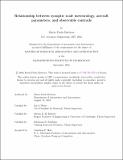Relationship between synoptic scale meteorology, aircraft parameters, and observable contrails
Author(s)
Barbosa, Maria Paula
DownloadThesis PDF (6.238Mb)
Advisor
Waitz, Ian A.
Barrett, Steven R. H.
Eastham, Sebastian D.
Terms of use
Metadata
Show full item recordAbstract
Long-lasting or "persistent" contrails are line-shaped clouds that form when airplanes fly through cold and humid parts of the atmosphere that are ice-supersaturated. Various studies have shown that persistent contrails may be responsible for more than half of aviation’s radiative forcing [1]. Efforts to mitigate persistent contrail formation include operational contrail avoidance. Current research suggests that minor (∼ 2000 ft) deviations in altitude of flights during cruise, in conjunction with advancing engine technologies, have the potential to reduce contrail climate forcing by approximately 90% [2]. Identifying and attributing observed contrails to specific individual flights is necessary to demonstrate the success of flight deviations. Reliable flight attribution, therefore, is critical in verifying large-scale implementation of contrail avoidance strategies. Flight attribution leverages both Earth-observation methods, such as satellite images and weather data, and flight data. However, temporal and spatial "blindspots" in satellite instruments, coupled with uncertainties in wind fields, have hindered reliable flight attribution. In this work, we consider eight different probabilistic flight attribution algorithms. All algorithms rely on the use of "similarity measures" which we define as the differences in distance, heading, and altitude between a contrail and flight line segment candidates. We define two-dimensional (2D) algorithms as those that use only distance and heading difference measures and the ones that additionally include altitude as three-dimensional (3D) algorithms. The probabilistic aspect of all eight algorithms is intended to account for errors in wind data and relies on the calculation of a Gaussian probability density function for each similarity measure. In an attempt to mitigate wind and positional errors that compound over time, four of the algorithms feature the inclusion of contrails from previous timestamps as potential match candidates. To account for the changes in flight path due to temporal factors, four of the algorithms include the use of time-dependent Gaussian parameters. The inputs to all algorithms include contrail detections, weather data, and flight data. To perform this analysis, a dataset of 180 manually-attributed, unique contrails was created that captures regional (across the continental United States) and diurnal variation. Each contrail was tracked for part of its lifetime, which results in the generation of 1980 total attributions. These attributions were created by seven labelers, with some overlapping scenes. A parameter sweep was performed on the four 2D algorithms to determine locally optimal Gaussian parameters. This sweep was performed on a reduced dataset that consists of 32 unique contrails and 218 total labels. The results of this sweep show that the performance of the algorithms, when using optimal Gaussian parameters, range from 79.7% to 83.6% accuracy. Accuracy is defined as the percentage of contrails that were attributed to the correct flights. These results are solely for the 2D algorithms that were analyzed on the reduced dataset. We then applied the "locally" optimal Gaussian parameters from the four 2D algorithms to the respective 3D algorithms and ran all eight algorithms on the remaining 148 contrails (1762 labels). We find that the optimal performance for all eight algorithms ranges from 68.2% to 76.2%. A deeper analysis is also conducted to evaluate the scene conditions that affect algorithm performance.
Date issued
2024-09Department
Massachusetts Institute of Technology. Department of Aeronautics and AstronauticsPublisher
Massachusetts Institute of Technology